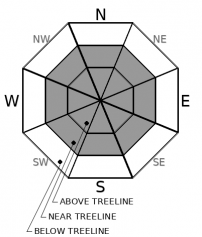| Tuesday | Tuesday Night | Wednesday | |
|---|---|---|---|
| Weather: | Mostly cloudy. Scattered snow showers. Snow levels below 7000 feet. Chance of precipitation is 50%. | Partly cloudy. Snow levels below 7000 feet. Chance of precipitation is 10%. | Partly cloudy. Snow levels below 7000 feet. Chance of precipitation is 5%. |
| Temperatures: | 28 to 33. deg. F. | 12 to 22. deg. F. | 35 to 40. deg. F. |
| Mid Slope Winds: | North 10 to 15 mph with gusts to 35 mph. | Northeast 10 to 15 mph with gusts to 30 mph. | Light winds. |
| Expected snowfall: | Up to 1 inch. | SWE = less than 0.10 inch. | No accumulation. | SWE = none. | No accumulation. | SWE = none. |
| Tuesday | Tuesday Night | Wednesday | |
|---|---|---|---|
| Weather: | Mostly cloudy. Scattered snow showers. Snow levels below 7000 feet. Chance of precipitation is 45%. | Partly cloudy. Snow levels below 7000 feet. Chance of precipitation is 10%. | Partly cloudy. Snow levels below 7000 feet. Chance of precipitation is 5%. |
| Temperatures: | 25 to 30. deg. F. | 14 to 20. deg. F. | 32 to 37. deg. F. |
| Ridge Top Winds: | North 15 to 25 mph with gusts to 45 mph. | Northeast 15 to 30 mph with gusts to 55 mph. | North 15 to 25 mph. Gusts up to 50 mph decreasing to 40 mph in the afternoon. |
| Expected snowfall: | Up to 1 inch. | SWE = less than 0.10 inch. | No accumulation. | SWE = none. | No accumulation. | SWE = none. |



























